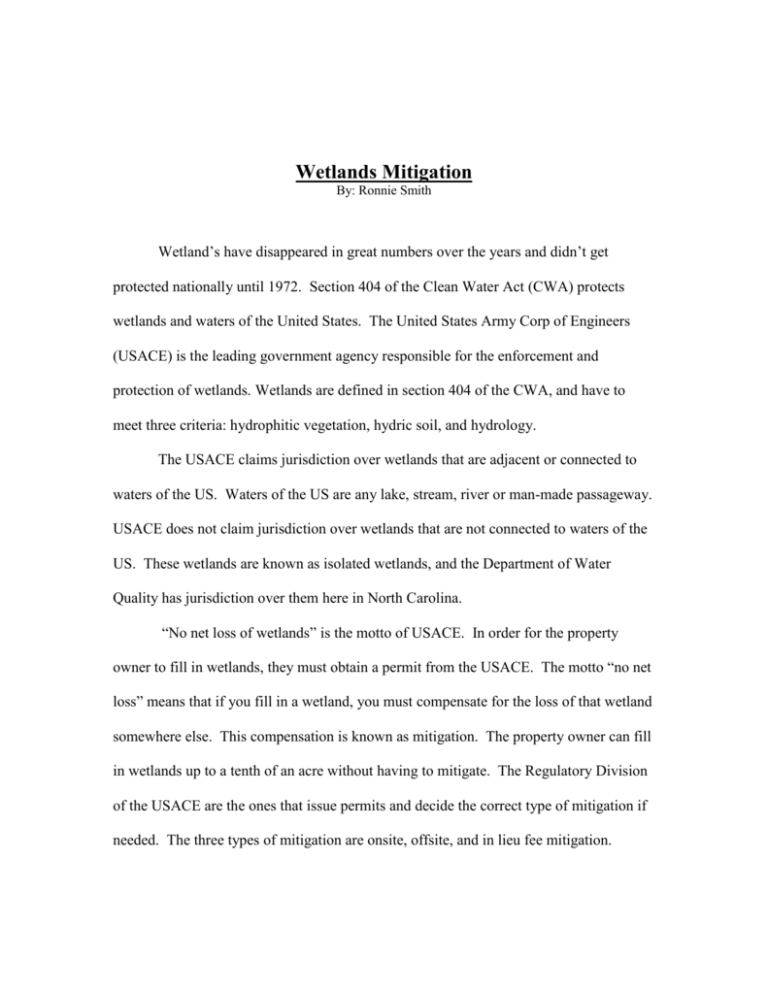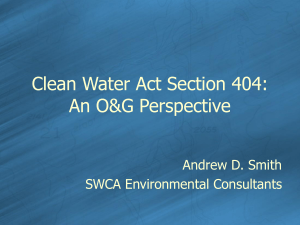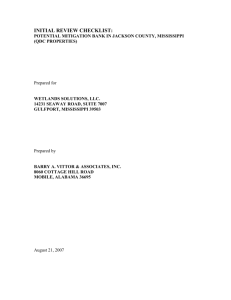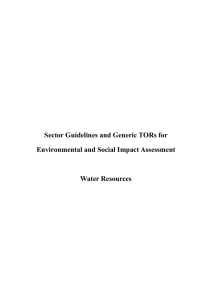Wetlands Mitigation - People Server at UNCW
advertisement

Wetlands Mitigation By: Ronnie Smith Wetland’s have disappeared in great numbers over the years and didn’t get protected nationally until 1972. Section 404 of the Clean Water Act (CWA) protects wetlands and waters of the United States. The United States Army Corp of Engineers (USACE) is the leading government agency responsible for the enforcement and protection of wetlands. Wetlands are defined in section 404 of the CWA, and have to meet three criteria: hydrophitic vegetation, hydric soil, and hydrology. The USACE claims jurisdiction over wetlands that are adjacent or connected to waters of the US. Waters of the US are any lake, stream, river or man-made passageway. USACE does not claim jurisdiction over wetlands that are not connected to waters of the US. These wetlands are known as isolated wetlands, and the Department of Water Quality has jurisdiction over them here in North Carolina. “No net loss of wetlands” is the motto of USACE. In order for the property owner to fill in wetlands, they must obtain a permit from the USACE. The motto “no net loss” means that if you fill in a wetland, you must compensate for the loss of that wetland somewhere else. This compensation is known as mitigation. The property owner can fill in wetlands up to a tenth of an acre without having to mitigate. The Regulatory Division of the USACE are the ones that issue permits and decide the correct type of mitigation if needed. The three types of mitigation are onsite, offsite, and in lieu fee mitigation. The districts of the USACE use a watershed and ecosystem based approach when determining where to mitigate. The goal of mitigation is to replace the lost resource with wetlands equal in physical, chemical and biological characteristics. With the mitigated wetland being in the same locality and watershed it is more likely that it will take on the same aquatic function as the one that was lost. Acreage is the unit mitigation is based upon and must meet a certain ratio for the four different options. Mitigation can be done through restoration, enhancement, creation, and preservation. A ratio of 2 acres of restored wetland to 1acre of filled wetland (2:1) is required when restoration is applied. Restoration is the changing of physical, chemical and biological characteristics of sites that have been degraded in some form. The two types of restoration are re-establishment and rehabilitation. Re-establishment results in a gain of wetlands and rehabilitation does not. A 3:1 ratio is required for the creation option. Creation is converting non-wetland to wetland and results in a gain in wetland acreage. A ratio of 4:1 is required for the enhancement option. Enhancement does not create more wetland acres but it improve specific functions of undisturbed or degraded wetlands. The purposes for enhancement are for water quality improvement, wildlife habitat, etc. Preservation is the last option and requires a ratio of 10:1. Since there is no restoration or creation of wetlands involved, the ratio is much higher. The ratio is flexible for the type of wetland you are mitigating for. If you are preserving a higher quality wetland than what you are taking away, then the ratio will be smaller. This works the other way around as well. When preservation is used it must be accompanied with a unit of restoration per acre. All of these ratios are assigned to on-site and off-site mitigation. On-site mitigation is when you mitigate in areas adjacent to the wetland being affected, usually on your own property. This is the most preferable type of mitigation because it is likely that it will compensate for locally important functions like wildlife habitat and water quality. This is the watershed approach in action. On-site mitigation must follow an approved USACE, and will be in violation if it does not comply with all the terms and conditions of the plan. A few of the terms and conditions are the types of aquatic resources being restored, enhanced, created or preserved, a monitoring plan, and an annual report of the success. When on-site mitigation is not practicable, off-site mitigation is considered. When one mitigates off site, they buy credits from a mitigation bank for the number of acres to be replaced. The bank creates, restores, enhances, or preserves wetlands with these credits. The majority of mitigation banks are privately owned and have strict guidelines to ensure that it is successful in its aquatic functions. When proposing and maintaining a bank, the owner must follow the Mitigation Bank Review Team (MBRT) requirements. Some of the requirements are that it must have a high probability of success, improve ecologic conditions of the regional watershed, etc. Most of the banks are sited in wetland areas that are in poor condition, like prior converted farmland. The one buying credits from a bank must purchase from one in the same 8 digit hydrologic unit code (HUC) watershed. Examples of these HUC’s are the North East Cape Fear and New Watershed’s. One may purchase credits from a bank in a different watershed under special circumstances, as long as it is in the same eco-region and obtains the same ecological function. When on-site and off-site mitigation is not practicable or recommended, in lieu fee mitigation is used. In cases where a mitigation bank is in your watershed, but the wetland type is not identified by the bank, in lieu fee mitigation can be used. In lieu fee mitigation is used for a lot of DOT projects since adjacent land can be bought for that purpose. Wetlands are abundant in the flat coastal plains of eastern North Carolina and play an important role for our environment and economy. Growth of the coastal areas in NC and other places are a growing threat to wetlands. On-site mitigation is the best way to mitigate but is not always practicable. Mitigation banking is the alternative and is not as efficient. The long term success of mitigation banks are unknown and do not always function better than the filled wetland. Trading high quality wetland for low quality wetland is also inefficient. Even though the conversion ratio is higher, the energy and productivity is not matched. Mitigation is needed to reduce negative hydrologic and ecologic impacts and to meet the “no net loss of wetlands” goal.








